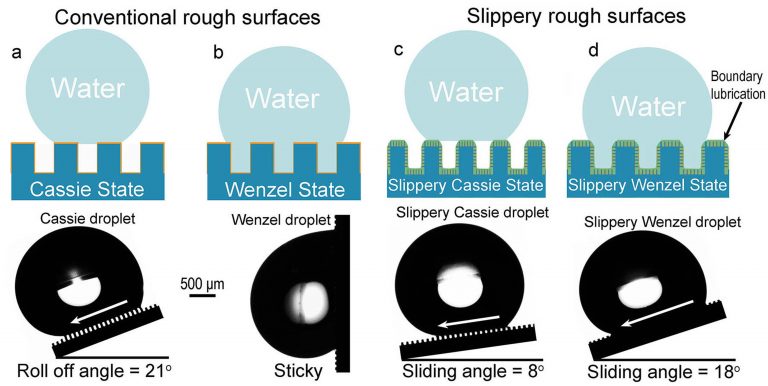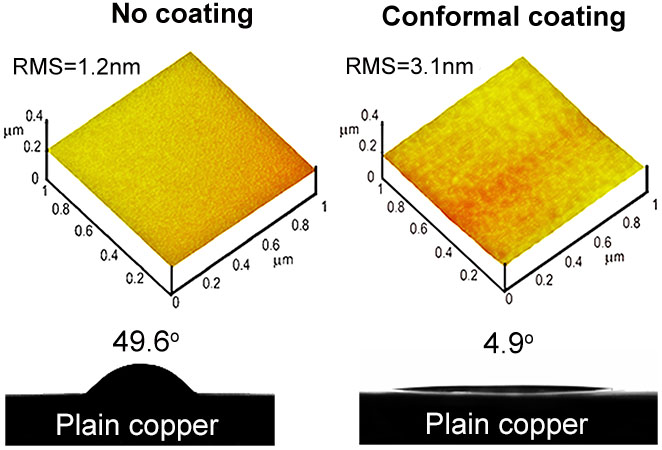Current Research
Our current research focuses on solving the critical energy, water and health issues in our society. We conduct interdisciplinary research to break the conventional academic barriers and provide new solutions to the scientific and engineering communities.
Our research is related to both science and engineering. Particularly, we have strong interests in energy efficiency, packaging, thermal management, biotransport, and emerging technologies.
We acknowledge our sponsors for their funding supports on our research projects.

Research accomplishments before UT Dallas (summarized in 2016)
1. Scalable materials for water and energy sustainability
Water and energy issues are very important in our daily life. Surface design is critical for water harvesting and energy efficiency. Enhancing the mobility of water droplets (or even vapor) on rough surfaces has the potential to improve condensation heat transfer for power-plant heat exchangers, create a more efficient water harvesting system for arid regions, prevent over-icing and frosting on aircraft wings, and protect medical implants from the gunk that can build up and ruin the material.

Xianming Dai, Nan Sun, Steven O. Nielsen, Birgitt Boschitsch Stogin, Jing Wang, Shikuan Yang, and Tak-Sing Wong, “Hydrophilic Directional Slippery Rough Surfaces for Water Harvesting“, Science Advances 4(3), eaaq0919 (2018). [Video]
Highlighted by National Science Foundation Science360 as top story of the day.
Reported by New Scientist, ACS C&EN, Science Magazine, EurekAlert (AAAS), ZME Science, Science Daily, XINHUA NET.
Xianming Dai, Birgitt Boschitsch Stogin, Shikuan Yang, and Tak-Sing Wong, “Slippery Wenzel State“, ACS Nano 9(9), 9260-9267 (2015). [Video]
Selected as one of the JALA Ten 2016, due to its deep impact on how technology is used across a wide range of disciplines.
Rank NO. 1 among the ACS Nano Most Downloaded Articles in the past 12 months.
Featured in NSF Science360 as the top story of the day.
2. Nanomaterials for evaporative cooling, vapor chamber and heat pipe
Passive cooling technologies are highly desirable in our daily life, such as the thermal management for electronic devices, batteries and fuel cells, as well as the cooling for LED lights and photovoltaic systems. All these applications demand effective cooling to reduce the operating temperature, and in turn ensure safety and reliability. For example, our computers require effective heat dissipations to maintain proper functioning. One of the most important cooling technology is the evaporation heat transfer.

Xianming Dai, Fanghao Yang, Ronggui Yang, Yung-Cheng Lee, and Chen Li, “Micromembrane-enhanced capillary evaporation”, International Journal of Heat and Mass Transfer, 64 (2013) 1101-1108.
Xianming Dai, Levey Tran, Fanghao Yang, Bo Shi, Ronggui Yang, YC Lee, and Chen Li, “Characterization of hybrid-wicked copper acetone heat pipes”, Proceedings of the ASME/JSME 2011 8th Thermal Engineering Joint Conference (AJTEC2011), March 13-17, 2011, Honolulu, Hawaii, USA. (ISI index).
Xianming Dai, Xinyu Huang, Fanghao Yang, Xiaodong Li, Joshua Sightler, Yingchao Yang, Chen Li, “Enhanced nucleate boiling on horizontal hydrophobic-hydrophilic carbon nanotube coatings”, Applied Physics Letters, 102(16) (2013) 161605.
Xianming Dai, Fanghao Yang, Ronggui Yang, Xinyu Huang, William A Rigdon, Xiaodong Li, Chen Li, “Biphilic nanoporous surfaces enabled exceptional drag reduction and capillary evaporation enhancement”, Applied Physics Letters, 105(19) (2014) 191611.
3. Microfluidic electronics cooling
The increased density of electronic components has pushed heat generation and power dissipation to unprecedented levels. Current thermal management solutions are unable to limit the temperature rise of these components. People can use larger cooling devices, but this results in complex military systems because the inefficiency of existing thermal management hardware will require the use of large volume and complex cooling systems. We used microfluidics as a new approach to address the next-generation cooling challenges.

Xianming Dai, Fanghao Yang, Ruixian Fang, Tsegaye Yemame, Jamil A Khan, Chen Li, “Enhanced single-and two-phase transport phenomena using flow separation in a microgap with copper woven mesh coatings”, Applied Thermal Engineering, 54(1) (2013) 281-288.
Fanghao Yang, Xianming Dai, Chih-Jung Kuo, Yoav Peles, Jamil Khan, Chen Li, “Enhanced flow boiling in microchannels by self-sustained high frequency two-phase oscillations”, International Journal of Heat and Mass Transfer, 58(1) (2013) 402-412.
Fanghao Yang, Xianming Dai, Yoav Peles, Ping Cheng, Jamil Khan, Chen Li, “Flow boiling phenomena in a single annular flow regime in microchannels (II): Reduced pressure drop and enhanced critical heat flux”, International Journal of Heat and Mass Transfer, 68 (2014) 716-724.
Fanghao Yang, Xianming Dai, Yoav Peles, Ping Cheng, Jamil Khan, Chen Li, “Flow boiling phenomena in a single annular flow regime in microchannels (I): Characterization of flow boiling heat transfer”, International Journal of Heat and Mass Transfer, 68 (2014) 703-715.
4. Fundamental study of phase change heat transfer
Guided by the Wenzel’s law, the apparent contact angle can be dramatically reduced via increasing the roughness of a hydrophilic surface. As a result, engineered surfaces with microscale, nanoscale, and hierarchical structures were developed to enhance boiling and evaporation. We studied the influence of surface structure and interfacial wettability on phase change heat transfer.

Xianming Dai, Pengtao Wang, Fanghao Yang, Xiaochuan Li, Chen Li, “Decoupling the influence of surface structure and intrinsic wettability on boiling heat transfer“. Applied Physics Letters, 112(25), 253901 (2018).
Xianming Dai, Mehdi Famouri, Aziz I Abdulagatov, Ronggui Yang, Yung-Cheng Lee, Steven M George, Chen Li, “Capillary evaporation on micromembrane-enhanced microchannel wicks with atomic layer deposited silica”, Applied Physics Letters, 103(15) (2013) 151602.
You must be logged in to post a comment.